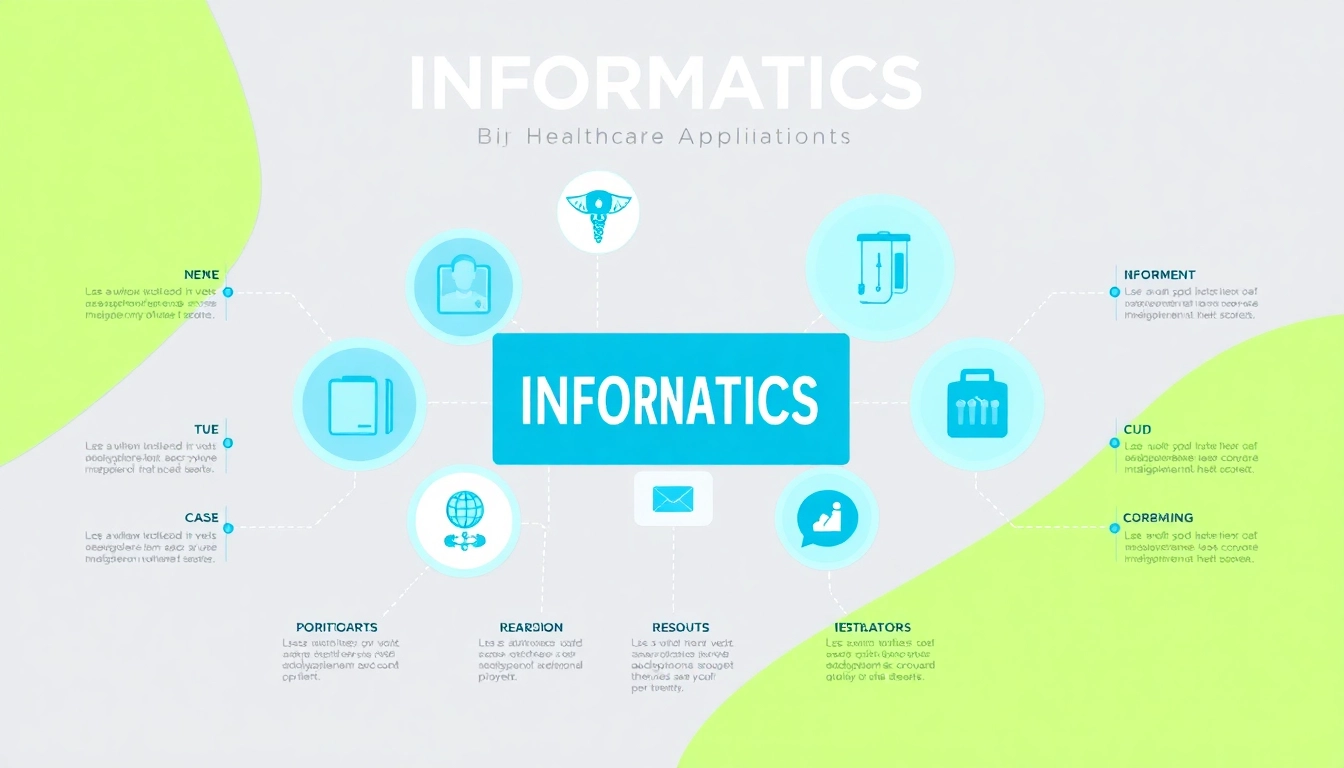
Understanding Informatics in Healthcare
In today’s rapidly evolving healthcare landscape, informatics stands out as a crucial component that significantly transforms healthcare delivery. By leveraging vast amounts of data, advanced technology, and systems thinking, informatics enhances various aspects of health management, ultimately improving patient outcomes and streamlining operations. As healthcare providers strive to navigate challenges and seize new opportunities, understanding the intricacies of informatics has never been more critical. For those looking to delve deeper into the realm of healthcare informatics, https://www.informaticsview.com offers valuable insights, resources, and guidance.
What is Informatics?
Informatics is the interdisciplinary field that aims to harness data, information, and technology to improve healthcare services and outcomes. At its core, it fuses elements from computer science, information science, and healthcare practice to create systems that can effectively process and analyze data in a way that informs clinical decision-making. According to the definition provided by the American Medical Informatics Association (AMIA), “informatics is the science of how to use data, information, and knowledge to improve human health and the delivery of healthcare services.” This broad definition encompasses various sub-disciplines, including clinical informatics, public health informatics, bioinformatics, and nursing informatics, making it applicable across many areas of healthcare.
The Role of Informatics in Modern Medicine
Informatics plays an indispensable role in modern medicine. One of its primary functions is to facilitate the efficient exchange of information between various stakeholders in the healthcare ecosystem, including patients, providers, payers, and regulators. By centralizing patient data, healthcare organizations can enhance communication and collaboration, leading to more coordinated and integrated care.
Moreover, informatics has made it possible to apply data analytics and artificial intelligence (AI) in clinical settings, improving diagnostic accuracy and treatment effectiveness. For example, predictive analytics can help healthcare providers identify at-risk populations and intervene early, while Clinical Decision Support Systems (CDSS) can provide evidence-based recommendations at the point of care.
The growing adoption of electronic health records (EHRs) reflects informatics’ role in data management. EHRs centralize patient information, making it readily accessible to a variety of healthcare professionals, thus enhancing clinical workflow and documentation efficiency. Additionally, informatics contributes to improving the overall patient experience by enabling telemedicine and remote monitoring solutions that allow patients to receive care from the comfort of their homes.
Key Technologies Used in Health Informatics
Modern health informatics leverages several key technologies to optimize data processing, enhance patient care, and streamline operations. Some of these technologies include:
- Electronic Health Records (EHRs): EHRs provide a digital anatomy of patient health, integrating all aspects of healthcare treatment into a single accessible platform.
- Telehealth Platforms: These facilitate remote consultations and follow-ups, enabling healthcare providers to reach and monitor patients outside traditional clinical settings.
- Clinical Decision Support Systems (CDSS): Utilizing patient data and best practices, CDSS alerts healthcare professionals to potential issues and provides recommendations for care.
- Health Information Exchange (HIE): HIEs enable the sharing of patient information between different organizations to improve care coordination and patient safety.
- Wearable Health Tech: Devices such as fitness trackers and smartwatches collect and relay real-time health data, promoting preventive care and self-management.
Major Applications of Informatics
Electronic Health Records (EHRs)
EHRs represent one of the most pivotal applications of informatics in healthcare. Functioning as a digital repository for patient information, EHRs facilitate real-time access to health records among various healthcare providers and institutions. By moving away from paper records, EHRs also decrease the likelihood of errors associated with manual data entry.
The implementation of EHRs has numerous benefits, including:
- Improved Patient Safety: EHRs allow for accurate and timely access to patient information, reducing the risk of medication errors and adverse drug interactions.
- Streamlined Workflow: Through standardized data entry processes, EHRs enhance efficiency and free up healthcare professionals to focus more on patient care.
- Enhanced Data Sharing: EHRs enable better collaboration across multidisciplinary teams, ensuring that everyone involved in a patient’s care has access to comprehensive and up-to-date information.
Clinical Decision Support Systems (CDSS)
Clinical Decision Support Systems are advanced software tools that analyze patient data and provide healthcare professionals with tailored recommendations at critical decision points. By integrating evidence-based knowledge into clinical workflows, CDSS enhances healthcare quality and reduces the risk of errors.
Key features and advantages of CDSS include:
- Real-Time Recommendations: CDSS provides on-the-go guidance based on current patient data and established clinical guidelines.
- Improved Diagnostic Accuracy: By highlighting potentially overlooked factors or suggesting further testing, CDSS aids clinicians in making more informed diagnoses.
- Quality Improvement: Continuous data analysis helps identify trends and areas for improvement within clinical processes, incentivizing better patient care.
Telemedicine and Remote Monitoring
In the age of technology-driven healthcare, telemedicine and remote monitoring systems have emerged as game changers, allowing healthcare providers to deliver care remotely while engaging with patients through digital platforms. These technologies enable patients to seek care without the barriers of distance, inefficient scheduling, or traveling concerns.
Benefits of telemedicine and remote monitoring include:
- Accessibility: Patients in rural or underserved areas can access specialized care without the constraints of geography.
- Patient Engagement: Patients can take a more active role in their healthcare through remote monitoring tools that encourage self-management and regular feedback.
- Cost-Effectiveness: Telemedicine often reduces costs associated with in-person visits, transportation, and hospitalizations, making it a beneficial option for healthcare systems and patients alike.
Impact on Patient Care
Improving Patient Outcomes
The integration of informatics in healthcare delivers significant improvements in patient outcomes. By promoting the use of data for personalized medicine, healthcare providers can tailor treatments to individual patient’s needs, preferences, and unique medical histories, thereby enhancing their overall care experience.
Furthermore, increased access to data allows for longitudinal studies comparing treatment effectiveness, thereby reducing redundancy and ensuring that patients receive the most appropriate therapeutic options. Ultimately, these practices contribute to increased patient safety and satisfaction, as well as better health outcomes.
Data-Driven Decision Making
Informatics empowers healthcare providers to make informed decisions by utilizing comprehensive data analysis. With clinical decision support tools and analytics platforms, clinicians can evaluate patient information in context, leading to more accurate diagnoses and improved treatment plans.
The result is a sweeping shift from reactive to proactive care. Instead of merely reacting to illnesses, healthcare professionals can identify potential health issues before they escalate, promoting preventive care and chronic disease management strategies.
Challenges Faced
While the benefits of informatics are considerable, numerous challenges persist. Issues such as data security, interoperability, and user training pose significant barriers to successful implementation. For instance, ensuring patient data privacy within EHRs remains a critical concern, especially as cyber threats evolve. Additionally, disparate systems that lack standardized protocols could hinder the effective exchange of health information.
To address these challenges, organizations must prioritize comprehensive training for staff and invest in robust cybersecurity measures. Promoting interoperability standards can also facilitate smoother data sharing and collaboration among healthcare providers.
Learning and Development in Informatics
Educational Pathways and Certifications
Selecting a career in health informatics entails exploring diverse educational pathways and certification programs. Various institutions offer specialized training in informatics, ranging from undergraduate degrees and certifications to master’s programs and doctoral studies. These programs equip aspiring informaticians with the necessary skills and knowledge to thrive in the healthcare industry.
Some prominent certification programs include:
- Certified Health Informatician (CHI): This certification focuses on proficiency in health informatics principles and practices.
- Certified Professional in Healthcare Information and Management Systems (CPHIMS): Recognized internationally, this credential validates expertise in healthcare informatics management.
- Health Information Management (HIM): Professionals can gain certification in HIM, further validating their expertise in data privacy, regulatory compliance, and informatics.
Online Resources and Communities
Numerous resources exist for those looking to deepen their knowledge in health informatics. Online platforms, forums, and networks provide valuable information, updates on industry trends, and opportunities for professional development.
Key online resources include:
- Online Education Platforms: Websites such as Coursera, edX, and FutureLearn offer courses tailored to various aspects of health informatics, taught by industry experts.
- Professional Associations: Membership in organizations like AMIA or HIMSS provides access to webinars, articles, and networking events, fostering continuous learning and growth.
- A Research Journals: Publications such as the Journal of the American Medical Informatics Association (JAMIA) present the latest findings and case studies in the field, keeping practitioners informed about cutting-edge developments.
Future Trends in Health Informatics
As the healthcare landscape continues to evolve, several trends are shaping the future of informatics. Some key trends include:
- Big Data Analytics: Harnessing vast datasets will enable healthcare organizations to discover insights that enhance patient care, operational efficiency, and overall health outcomes.
- Artificial Intelligence in Healthcare: AI applications, such as predictive analytics and natural language processing, will revolutionize how data is interpreted, driving innovations in diagnosis and treatment.
- Interoperability Standards: The push for seamless data exchange between different health IT platforms will continue to grow, promoting more coordinated care and improved patient experiences.
Measuring Success in Informatics Initiatives
Key Performance Indicators (KPIs)
To effectively measure the success of informatics initiatives, healthcare organizations should set clear benchmarks and track relevant KPIs. Metrics may include:
- Patient Wait Times: Reductions in wait times can indicate improvements in operational efficiency and patient satisfaction.
- Clinical Outcomes: Tracking health outcomes across patient populations can help assess the effectiveness of informatics solutions in improving care.
- Data Entry Errors: Decreases in errors associated with data entry can reflect better usability and reliability of informatics systems.
Case Studies and Real-World Examples
Several organizations have successfully implemented informatics solutions that demonstrate tangible benefits. For instance, the Mayo Clinic has successfully used predictive analytics to improve patient scheduling and reduce wait times, ultimately enhancing patient satisfaction. Another example is Geisinger Health System, which has incorporated CDSS into their EHRs, yielding improvements in diagnosis accuracy and treatment adherence.
These case studies illuminate the potential of informatics to drive operational efficiency and improve patient care while serving as powerful examples for organizations seeking to optimize their own informatics efforts.
The Future of Health Informatics
Looking ahead, the landscape of health informatics will continue to be influenced by technological advancements, regulatory changes, and shifting consumer expectations. The potential for transformative technologies, such as blockchain for data security and enhanced privacy, is only beginning to be realized.
As healthcare providers embrace continuous innovation and advancement in informatics, they will be better positioned to navigate complex challenges and deliver high-quality care that enhances patient outcomes and operational effectiveness. Pursuing ongoing education, collaboration, and adherence to best practices will remain critical as informatics continues to evolve and play a central role in the future of healthcare.







